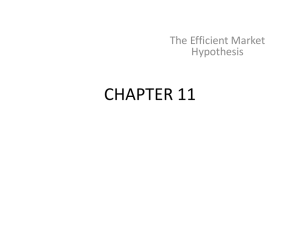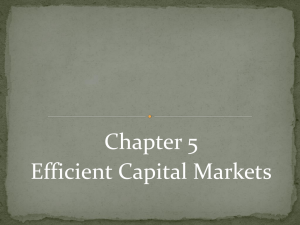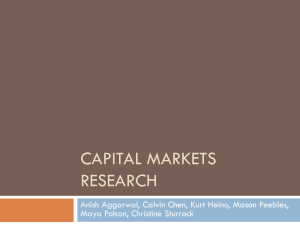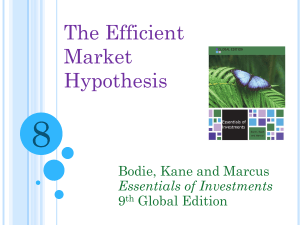PP06
advertisement
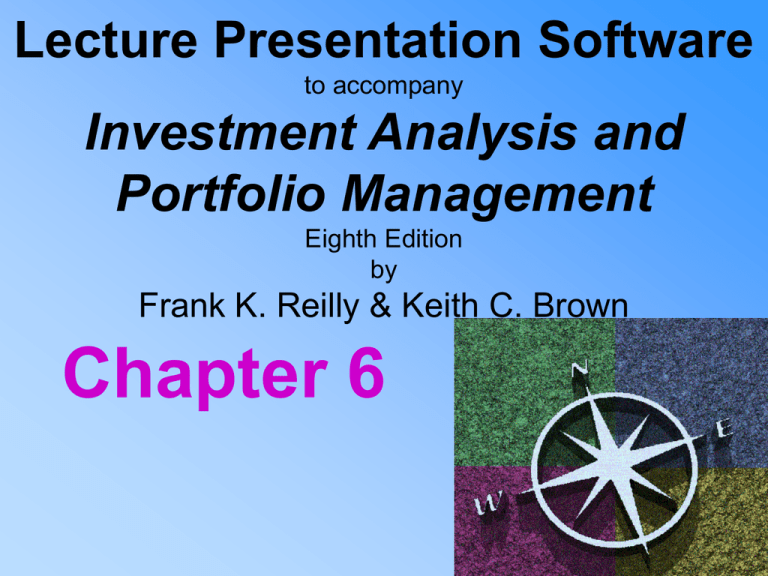
Lecture Presentation Software to accompany Investment Analysis and Portfolio Management Eighth Edition by Frank K. Reilly & Keith C. Brown Chapter 6 Chapter 6 Efficient Capital Markets Questions to be answered: • • • • What is does it mean to say that capital markets are efficient? Why should capital markets be efficient? What factors contribute to an efficient market? Given the overall efficient market hypothesis, what are the three sub-hypotheses and what are the implications of each of them? • How do you test the three efficient market hypothesis (EMH) and what are the results of the tests? • For each set of tests, which results support the hypothesis and which results indicate an anomaly related to the hypothesis? • What is behavioral finance and how does it relate to the EMH? Chapter 6 Efficient Capital Markets • What are the major findings of behavioral finance and what are the implications of these findings for EMH? • What are the implications of the efficient market hypothesis test results for – – – – Technical analysis? Fundamental analysis? Portfolio managers with superior analysts? Portfolio managers with inferior analysts? What Constitutes An Efficient Capital Market? • Two forms of market efficiency – Informational efficiency – the subject of this chapter – Transactional efficiency – minimize cost • Economies of scale • Economies of scope • In an efficient capital market, security prices – Reflect all available information – Adjust rapidly to the arrival of new information. • Whether markets are efficient has been extensively researched and remains controversial Why Should Capital Markets Be Efficient? The premise of an efficient market: – A large number of competing profit-maximizing participants analyze and value securities, each independently of the others – New information regarding securities comes to the market in a random fashion – Profit-maximizing investors rapidly adjust (in an unbiased fashion) security prices to reflect the impact of new information Conclusion: In an efficient market, the expected returns implicit in the current price of a security should reflect its risk Alternative Efficient Market Hypotheses (EMH) • Random Walk Hypothesis – first hypothesized by Louis Bachlier, a French doctoral student in mathematics, in 1900. Said that changes in security prices occur randomly & unpredictably. • Eugene Fama (1970) Fair Game Model – current market price reflect all available information about a security and the expected return based upon this price is consistent with its risk • Efficient Market Hypothesis (EMH) – Fama divided EMH into three sub-hypotheses depending on the information set involved – Weak-form efficient – Semi-strong form efficient – Strong-form efficient Efficient Market Hypotheses (EMH) • Weak-Form EMH - prices reflect all information contained in the past record of prices & volumes • Semi-strong-form EMH - prices reflect all public information • Strong-form EMH - prices reflect all public and private information Weak-Form EMH • Current prices reflect all security-market information, including: – – – – – Historical sequence of prices, Trading volume data Rates of return Odd lot transactions Block trades • This implies that past rates of return and other market data is already captured by the current market price and thus should have no relationship with future rates of return – Past and future prices are independent Semi-strong-Form EMH • Current security prices reflect all public information, including market and non-market information • This implies that decisions made based on information already in the public domain should not lead to aboveaverage risk-adjusted profits from those transactions Strong-Form EMH • Stock prices fully reflect all information from both public and private sources • This implies that no group of investors should be able to consistently derive above-average risk-adjusted rates of return • This assumes perfect markets in which all information is cost-free and available to everyone at the same time Random Walk Theory: Microsoft Stock Price Changes from March 1990 to May 2004 For Microsoft stock over the period March 1990 to May 2004, the correlation between a price change on day t and a price change on day t+1 was +0.025. Random Walk Theory: Weekly Returns, May 1984 – May, 2004 FTSE 100 (correlation = -.08) Return in week t + 1, (%) FTSE is an independent company owned by The Financial Times and the London Stock Exchange. Their sole business is the creation and management of indices and associated data services, on an international scale. Return in week t, (%) Random Walk Theory: Weekly Returns, May 1984 – May, 2004 Nikkei 500 Return in week t + 1, (%) (correlation = -.06) Return in week t, (%) Random Walk Theory: Weekly Returns, May 1984 – May, 2004 DAX 30 Return in week t + 1, (%) (correlation = -.03) Return in week t, (%) Random Walk Theory: Weekly Returns, May 1984 – May, 2004 S&P Composite Return in week t + 1, (%) (correlation = -.07) Return in week t, (%) Tests and Results of Weak-Form EMH • Statistical Tests of Independence – Autocorrelation tests • Test for correlation between prices today and prices tomorrow • If EMH is true, would expect zero correlation – Runs tests • DeFusca et al, 2004 • Price increases assigned a positive sign; price decreases assigned a negative sign. Test for randomness in the pattern of signs. • Tests of Trading Rules – Filter Rules • A filter tells us to buy or sell depending on changes in market variables • The finer the filter, the higher the transactions costs Tests and Results of Weak-Form EMH • Testing constraints – Use only publicly available data – Include all transactions costs – Adjust the results for risk • Only better-known technical trading rules have been examined – Too much subjective interpretation of data – Almost infinite number of trading rules • Results generally support the weak-form EMH, but results are not unanimous – Tests using actual transactions data have shown positive correlation but not shown if profitable after transactions costs Tests of the Semistrong Form of Market Efficiency Two types of studies • Return prediction studies – Can we predict either: – Time series analysis of returns (predict future returns for one stock) – Cross sectional distribution of returns (predict which stocks will be in the top decile, etc.) • Event studies – Examine how fast stock prices adjust to specific economic events Tests and Results of Semistrong-Form EMH • Adjustment for Market Effects – Test results should adjust a security’s rate of return for the rate of return of the overall market during the period considered Abnormal rate of return ARit = Rit - Rmt where: ARit = abnormal rate of return on security i during period t Rit = rate of return on security i during period t Rmt =rate of return on a market index during period t Tests and Results of Semistrong-Form EMH • Time series tests for abnormal rates of return – short-horizon return studies have had limited success – long-horizon return studies have been quite successful based on • dividend yield (D/P) • default spread – difference in yield between B bonds & AAA bonds (acts as proxy for the market risk premium) • term structure spread – difference in yield between short & long Government bonds & T bills – When D/P and the default spread are high, implies that investors expect a high return on stocks & bonds. Tends to occur during poor economic environments (low growth rates and higher perceived risk by investors). Invest now for high future returns!! Tests and Results of Semistrong-Form EMH • More time series tests: – Quarterly earnings reports may yield abnormal returns due to • Due to unanticipated earnings change • Results suggest abnormal returns are earned in the 13 – 26 weeks after the announcement of large unanticipated earnings changes (referred to as an earnings surprise) • Studies by Rendleman et al found – 31% of the change in stock price before the announcement – 18% on the day of the announcement – 51% following the announcement date – These results do not support the EMH. Tests and Results of Semistrong-Form EMH • The January Anomaly – Stocks with negative returns during the year had higher returns immediately after the first of the new year • December trading volume abnormally high for these stocks • Most of the January effect occurs on the first trading day in the new year – Tax selling toward the end of the year has been mentioned as the reason for this phenomenon (although a similar pattern has been found in countries with different tax laws) – Such a seasonal pattern is inconsistent with the EMH Tests and Results of Semistrong-Form EMH • Other calendar effects – All the market’s cumulative advance occurs during the first half of trading months – Monday/weekend returns were significantly negative – For large firms, the negative Monday effect occurred before the market opened (it was a weekend effect) – For smaller firms, most of the negative Monday effect occurred during the day on Monday (it was a Monday trading effect) Tests and Results of Semistrong-Form EMH • Predicting cross-sectional returns – Basic premise: All securities should have equal, riskadjusted returns • Studies examine alternative measures of size or quality as a tool to rank stocks in terms of riskadjusted returns – These tests involve a joint hypothesis and are dependent both on market efficiency and the asset pricing model used Tests and Results of Semistrong-Form EMH • Price-earnings ratios and returns – Low P/E stocks experienced superior risk-adjusted results relative to the market, whereas high P/E stocks had significantly inferior risk-adjusted results – Publicly available P/E ratios possess valuable information regarding future returns • This is inconsistent with semistrong form efficiency Tests and Results of Semistrong-Form EMH • Price-Earnings/Growth Rate (PEG) ratios – Studies have hypothesized an inverse relationship between the PEG ratio and subsequent rates of return. – This is inconsistent with the EMH • However, the results related to using the PEG ratio to select stocks are mixed Tests and Results of Semistrong-Form EMH • The size effect (total market value) – Several studies have examined the impact of size on risk-adjusted rates of return – The studies show that small firms consistently experience significantly larger risk-adjusted returns than large firms • But some of the size effect seems to have disappeared – Firm size is a major efficient market anomaly Tests and Results of Semistrong-Form EMH • The P/E studies and size studies are dual tests of the EMH and the CAPM • Abnormal returns could occur because either – Markets are inefficient or – Market model is not properly specified and provides incorrect estimates of risk and expected returns Tests and Results of Semistrong-Form EMH • Neglected Firms – Neglected firms are those firms not followed by many analysts – Neglected firm effect caused by lack of information and limited institutional interest – Small-firm effect was confirmed – Another study contradicted the above results – Neglected firm concept applied across size classes Tests and Results of Semistrong-Form EMH • Ratio of Book Value of a firm’s Equity to Market Value of its equity – Significant positive relationship found between current values for this ratio and future stock returns – Results inconsistent with the EMH • Size and BV/MV appear to dominate other ratios such as P/E ratio or leverage • This combination only works during periods of loose monetary policy Tests and Results of Semistrong-Form EMH • Event studies – Stock split studies show that splits do not result in abnormal gains after the split announcement, but before – Initial public offerings seems to be underpriced by almost 18%, but that varies over time, and the price is adjusted within one day after the offering • Suppose you had bought stock immediately following each IPO & then held that stock for five years. • Over the period 1970 – 2002, your average annual return would have been 4.2% less than the return on a portfolio of similar-sized stock – Listing of a stock on an national exchange such as the NYSE may offer some short term profit opportunities for investors Tests and Results of Semistrong-Form EMH • Event studies (continued) – Stock prices quickly adjust to unexpected world events and economic news and hence do not provide opportunities for abnormal profits • Patell & Wolfson found that when new information is released, the major part of the adjustment in price occurs within 10 minutes of the announcement – Announcements of accounting changes are quickly adjusted for and do not seem to provide opportunities – Stock prices rapidly adjust to corporate events such as mergers and offerings – The above studies provide support for the semistrongform EMH Summary on the Semistrong-Form EMH • Evidence is mixed – Strong support from numerous event studies with the exception of exchange listing studies – Studies on predicting rates of return for a cross-section of stocks indicates markets are not semistrong efficient • Dividend yields, risk premiums, calendar patterns, and earnings surprises all appear to yield valuable information • Predictors such as size, the BV/MV ratio (when there is expansive monetary policy), P/E ratios, and neglected firms also appear to yield valuable information Tests and Results of Strong-Form EMH • Strong-form EMH contends that stock prices fully reflect all information, both public and private • This implies that no group of investors has access to private information that will allow them to consistently earn above-average profits Testing Groups of Investors • • • • Corporate insiders Stock exchange specialists Security analysts Professional money managers Corporate Insider Trading • Insiders include major corporate officers, directors, and owners of 10% or more of any equity class of securities • Insiders must report to the Securities Commission within 10 calendar days of a transaction in the stock of the firm for which they are an insider • These insider trades are made public within minutes of filing (note that the textbook refers to 6 weeks – in Canada, it is within five minutes of filing) • Corporate insiders generally experience above-average profits especially on purchase transaction Corporate Insider Trading • This implies that many insiders had private information from which they derived above-average returns on their company stock • Studies showed that public investors who traded with the insiders based on announced transactions would have enjoyed excess risk-adjusted returns (after commissions), but the markets now seems to have eliminated this inefficiency (soon after it was discovered) • Other studies indicate that you can increase returns from using insider trading information by combining it with key financial ratios and considering what group of insiders is doing the buying and selling Stock Exchange Specialists • Specialists have monopolistic access to information about unfilled limit orders • You would expect specialists to derive above-average returns from this information • The data generally supports this expectation Security Analysts • Tests have considered whether it is possible to identify a set of analysts who have the ability to select undervalued stocks • The analysis involves determining whether, after a stock selection by an analyst is made known, a significant abnormal return is available to those who follow their recommendations • There is evidence in favor of the existence of superior analysts – Warren Buffet, Peter Lynch (Fidelity Magellan Fund) Warren Buffet • Buffet Partnership Ltd (1957 – 1969) beat the Dow Jones Industrial Average every year of its existence, with a cumulative return of 2,749% versus the Dow’s cumulative return of 152.6% • Buffet acquired Berkshire Hathaway in 1965. • Since then he beat the return on the Dow in 36 out of 41 years • After tax cumulative return of 305,134% versus 5,583% (pre-tax) for the Dow. Ivan Boesky • By 1986 Ivan Boesky had become an arbitrageur who had amassed a fortune of about US$200 million by betting on corporate takeovers. • He was investigated by the US SEC for making investments based on tips received from corporate insiders. • These stock acquisitions were sometimes brazen, with massive purchases occurring only a few days before a corporation announced a takeover. • Although insider trading of this kind was illegal, laws prohibiting it were rarely enforced until Boesky was prosecuted. • Boesky cooperated with the SEC and informed on several of his insiders, including junk bond trader Michael Milken. • As a result of a plea bargain, Boesky received a prison sentence of 3.5 years and was fined US$100 million. • Although he was released after two years, he was barred from working in the securities business for the remainder of his life. The Value Line Enigma • Value Line (VL) publishes financial information on about 1,700 stocks • The report includes a timing rank from 1 down to 5 • Firms ranked 1 substantially outperform the market • Firms ranked 5 substantially underperform the market • Changes in rankings result in a fast price adjustment • Some contend that the Value Line effect is merely the unexpected earnings anomaly due to changes in rankings from unexpected earnings Professional Money Managers • Trained professionals, working full time at investment management • If any investor can achieve above-average returns, it should be this group • If any non-insider can obtain inside information, it would be this group due to the extensive management interviews that they conduct Performance of Professional Money Managers • Most tests examine mutual funds • New tests also examine trust departments, insurance companies, and investment advisors • Risk-adjusted, after expenses, returns of mutual funds generally show that most funds did not match aggregate market performance – Mark Carhart analyzed 1,493 mutual funds to see if professional money managers could out-perform the market – He found that, on average, mutual funds earn a lower return than the benchmark after expenses and roughly match the benchmark return before expenses Conclusions Regarding the Strong-Form EMH • Mixed results, but much support • Tests for corporate insiders and stock exchange specialists do not support the hypothesis – Both groups seem to have monopolistic access to important information and use it to derive above-average returns • Tests results for analysts are concentrated on Value Line rankings – Results have changed over time – Currently tend to support EMH • Individual analyst recommendations seem to contain significant information • Performance of professional money managers seem to provide support for strong-form EMH Behavioral Finance It is concerned with the analysis of various psychological traits of individuals and how these traits affect the manner in which they act as investors, analysts, and portfolio managers Explaining Biases • Prospect theory – Investors fear losses more than they value gains – Hold losers too long and sell winners too quickly • Overconfidence (confirmation bias) – Look for information that supports prior opinions and decisions • Noise traders – Tend to follow newsletter writers, who are almost always wrong – Tend to move as a herd, increasing volatility • Escalation bias – Add money to failures rather than successes – Concept of averaging down Fusion Investing • The integration of two elements of investment valuation – Fundamental value – Investor sentiment • Fundamental value is equal to the PV of expected future cash flows • Investor sentiment driven by noise traders – When noise traders are bullish, stock prices above fundamental value – When noise traders are bearish, stock prices are below fundamental value • Therefore, consider both fundamental value & investor sentiment prior to buying or selling Implications of Efficient Capital Markets • Overall results indicate the capital markets are efficient as related to numerous sets of information • However, there are substantial instances where the market fails to rapidly adjust to public information Efficient Markets and Technical Analysis • Assumptions of technical analysis directly oppose the notion of efficient markets • Technicians believe that new information is not immediately available to everyone, but disseminated from the informed professional first to the aggressive investing public and then to the masses • Technicians also believe that investors do not analyze information and act immediately - it takes time • Therefore, stock prices move to a new equilibrium after the release of new information in a gradual manner, causing trends in stock price movements that persist for periods of time Efficient Markets and Technical Analysis • Technical analysts develop systems to detect movement to a new equilibrium (breakout) and trade based on that • Contradicts rapid price adjustments indicated by the EMH • If the capital market is weak-form efficient, a trading system that depends on past trading data can have no value Efficient Markets and Fundamental Analysis • Fundamental analysts believe that there is a basic intrinsic value for the aggregate stock market, various industries, or individual securities and these values depend on underlying economic factors • Investors should determine the intrinsic value of an investment at a point in time and compare it to the market price Efficient Markets and Fundamental Analysis • If you can do a superior job of estimating intrinsic value you can make superior market timing decisions and generate above-average returns • This involves aggregate market analysis, industry analysis, company analysis, and portfolio management • Intrinsic value analysis should start with aggregate market analysis Aggregate Market Analysis with Efficient Capital Markets • EMH implies that examining only past economic events is not likely to lead to outperforming a buy-and-hold policy because the market adjusts rapidly to known economic events • Merely using historical data to estimate future values is not sufficient • You must estimate the relevant variables that cause longrun movements Industry and Company Analysis with Efficient Capital Markets • Wide distribution of returns from different industries and companies justifies industry and company analysis • Must – Understand the variables that effect rates of return – Do a superior job of estimating future values of these relevant valuation variables, not just look at past data • Important relationship between expected earnings and actual earnings – Must accurately predict earnings surprises • Strong-form EMH indicates likely existence of superior analysts • Studies indicate that fundamental analysis based on P/E ratios, size, and the BV/MV ratios can lead to abnormal returns How to Evaluate Analysts or Investors • Examine the performance of numerous securities that this analyst recommends over time in relation to a set of randomly selected stocks in the same risk class • Selected stocks should consistently outperform the randomly selected stocks Conclusion about Fundamental Analysis • Estimating the relevant variables is as much an art and a product of hard work as it is a science • The successful investor must understand what variables are relevant to the valuation processes and have the ability and work ethic to do a superior job of estimating these important valuation variables Efficient Markets and Portfolio Management • Portfolio Managers with Superior Analysts – Concentrate efforts in mid-cap stocks that do not receive the attention given by institutional portfolio managers to the top-tier stocks – The market for these neglected stocks may be less efficient than the market for large well-known stocks Efficient Markets and Portfolio Management • Portfolio Managers without Superior Analysts – Determine and quantify your client's risk preferences – Construct the appropriate portfolio – Diversify completely on a global basis to eliminate all unsystematic risk – Maintain the desired risk level by rebalancing the portfolio whenever necessary – Minimize total transaction costs The Rationale and Use of Index Funds and ExchangeTraded Funds • Efficient capital markets and a lack of superior analysts imply that many portfolios should be managed passively (so their performance matches the aggregate market & minimizes the costs of research and trading) • ETFs duplicate the composition and performance of many indices Insights from Behavioral Finance • Growth companies will usually not be growth stocks due to the overconfidence of analysts regarding future growth rates and valuations • Notion of “herd mentality” of analysts in stock recommendations or quarterly earnings estimates is confirmed The Internet Investments Online http://www.bloomberg.com http://news.ft.com http://www.online.wsj.com http://finance.yahoo.com http://money.cnn.com http://www.cnbc.com http://www.abcnews.com http://www.nbcnews.com http://www.msnbc.msn.com
